#Hylaeosaurus
Text

"What is to come"
(image id is both in the alt text and below the read more- I put it under one because it's incredibly long)
And so there we have it, the 200+ followers artpiece that I have been working on for several days, if I had to guess I'd say it took 25 or so hours over eleven days. Honestly it's so surreal to me that I'm here with over 200 followers (260 as of typing this- yes, I procrastinated on this), especially when I only hit 100 followers in February. It's genuinely really nice to know that people are actually interested in my art (before anyone brings up spam bots- I know there are a few of them amongst my followers but I've checked most of them and I am 100% confident that over 200 of them are real). I don't really have much else to say really- I'm just grateful to have the support. Thanks y'all :).
[Image id: a large, lineless digital drawing of several dinosaurs. It is nighttime. At the bottom of the piece, a lone Eoraptor lunensis is walking across the floodplains- both the ground and the Eoraptor are just silhouettes, the early dinosaur has been given protofeathers. The full moon is shining, it's size is exaggerated for artistic affect. Behind the moon, the heads of sixteen different dinosaurs can be seen (listed left to right, bottom to top) Row 1- Thecodontosaurus antiquus (small sauropodomorph with light brown protofeathers, near-white undersides, straight stripes that are moderately darker than the base colour and vibrant green eyes), Coelophysis bauri (small early theropod with a long and narrow skull, its protofeathers are golden and black. A soft orange stripe runs across the back of its head, it has warm brown eyes. Row 2- Plateosaurus trossingensis (long-necked sauropodomorph, it has reddish-brown scales, light undersides, triangular stripes running down it's spine that get bigger the further down they get and pale yellow eyes), Heterodontosaurus tuckii (small ornithopod with a hooked grey beak. It has spiky green feathers, a lighter chest and a darker stripe running along its head and back, there are three small spots on its face, two behind the eye and one infront of it, it's eyes are bright yellow). Row 3- Megalosaurus bucklandii (medium-sized theropod with warm brown feathers, lighter undersides, dark spots and bright yellow eyes, there are several scars on its face), Brachiosaurus altithorax (greenish-grey true sauropod with lighter undersides, a dark pink patch on its throat, dark desaturated brown eyes and a few small scars on its neck), Archaeopteryx (early toothed bird with a black head, white neck and bright yellow eyes). Row 4- Hylaeosaurus armatus (pale brown ankylosaur with lighter undersides and vibrant green eyes), Velociraptor mongoliensis (dromaeosaur with light brown feathers, a lighter chest, a black stripe near its eye and light green eyes), Sinosauropteryx prima (small compsognathid theropod with ginger protofeathers, an off white mask and undersides and pale yellow eyes), Iguanodon bernissartensis (large greenish-grey ornithopod with a slightly darker back, pale undersides, a grey beak, and yellow eyes). Row 5- Matuku otagoense (heron with medium grey feathers and a small crest. A red stripe runs from just behind its nostrils to about a third of the way down its neck. Its undersides are white, its beak is grey and its eyes are brown), Triceratops prorsus (three-horned ceratopsian with grey-brown scales, lighter undersides, two triangular stripes between it's brow and nasal horns, reddish-orange diamond-like stripes on its frill, a hooked grey beak and golden eyes. Its brow horns curve forward at the base. Row 6- North Island brown kiwi (plump brown bird with a long pale beak, whiskers and black eyes, its nostrils are at the tip of its bill, and unlike the other dinosaurs in the sky part of its body below the neck is visible), male house sparrow (small redish-brown and grey bird with a black bib below it's bill), it has brown eyes and a dark grey bill. Row 7- rock dove (grey bird with iridescent green feathers scattered across its neck, a dark grey beak, and warm brown eyes). end id]
#art#my art#digital art#paleoart#dinosaurs#birds#eoraptor#thecodontosaurus#coelophysis#plateosaurus#megalosaurus#brachiosaurus#archaeopteryx#hylaeosaurus#velociraptor#sinosauropteryx#iguanodon#matuku#triceratops#north island brown kiwi#house sparrow#rock dove
3K notes
·
View notes
Text
The first 3 dinosaurs

308 notes
·
View notes
Text
Crystal Palace Field Trip Part 2: Walking With Victorian Dinosaurs
[Previously: the Permian and the Triassic]
The next part of the Crystal Palace Dinosaur trail depicts the Jurassic and Cretaceous periods. Most of the featured animals here are actually marine reptiles, but a few dinosaur species do make an appearance towards the end of this section.

Although there are supposed to be three Jurassic ichthyosaur statues here, only the big Temnodontosaurus platyodon could really be seen at the time of my visit. The two smaller Ichthyosaurus communis and Leptonectes tenuirostris were almost entirely hidden by the dense plant growth on the island.

Ichthyosaurs when fully visible vs currently obscured
Left side image by Nick Richards (CC BY SA 2.0)
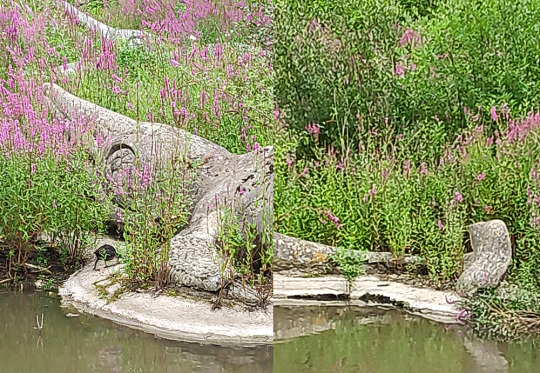
Head, flipper, and tail details of the Temnodontosaurus. A second ichthyosaur is just barely visible in the background.
Ichthyosaurs were already known from some very complete and well-preserved fossils in the 1850s, so a lot of the anatomy here still holds up fairly well even 170 years later. They even have an attempt at a tail fin despite no impressions of such a structure having been discovered yet! Some details are still noticeably wrong compared to modern knowledge, though, such as the unusual amount of shrinkwrapping on the sclerotic rings of the eyes and the bones of the flippers.

———

Arranged around the ichthyosaur, three different Jurassic plesiosaurs are also represented – “Plesiosaurus” macrocephalus with the especially sinuous neck on the left, Plesiosaurus dolichodeirus in the middle, and Thalassiodracon hawkinsi on the right.
They're all depicted here as amphibious and rather seal-like, hauling out onto the shore in the same manner as the ichthyosaurs. While good efforts for the time, we now know these animals were actually fully aquatic, that they had a lot more soft tissue bulking out their bodies, and that their necks were much less flexible.

———
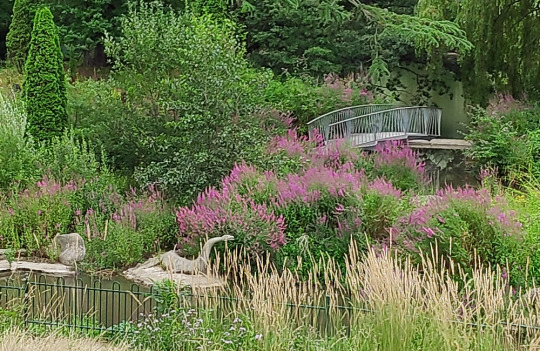
The recently-installed new pivot bridge is also visible here behind some of the marine reptiles.
———

Positioned to the left of the other marine reptiles, this partly-obscured pair of croc-like animals are teleosaurs (Teleosaurus cadomensis), a group of Jurassic semi-aquatic marine crocodylomorphs.

A better view of the two teleosaurs by MrsEllacott (CC BY-SA 4.0)
The Crystal Palace statues have the general proportions right, with long thin gharial-like snouts and fairly small limbs. But some things like the shape of the back of the head and the pattern of armored scutes are wrong, which is odd considering that those details were already well-known in the 1850s.

———
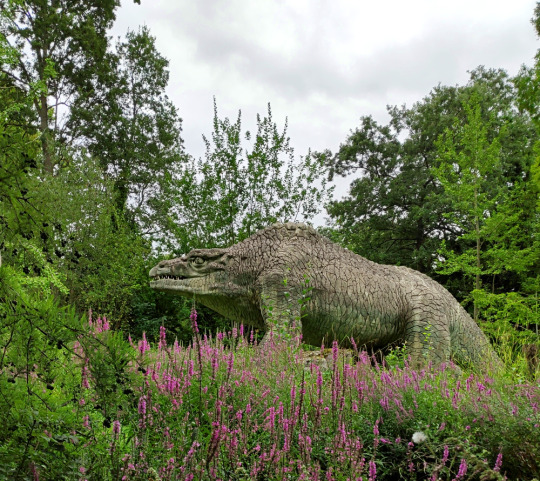
Finally we reach the first actual dinosaur, and one of the most iconic statues in the park: the Jurassic Megalosaurus!
Megalosaurus bucklandi was the very first non-avian dinosaur known to science, discovered in the 1820s almost twenty years before the term "dinosaur" was even coined.
At a time when only fragments of the full skeleton were known, and before any evidence of bipedalism had been found, the Crystal Palace rendition of Megalosaurus is a bulky quadrupedal reptile with a humped back and upright bear-like limbs. It's a surprisingly progressive interpretation for the period, giving the impression of an active mammal-like predator.
This statue suffered extensive damage to its snout in 2020, which was repaired a year later with a fiberglass "prosthesis".

———
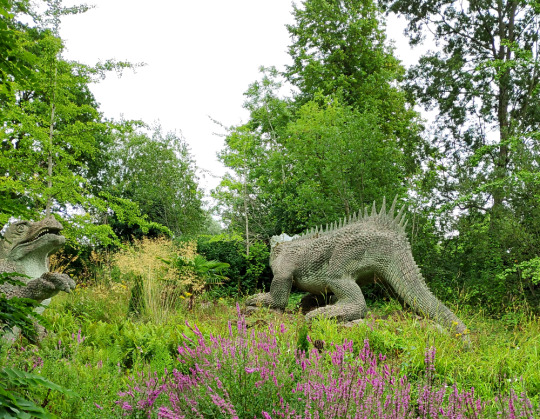
Reaching the Cretaceous period now, we find Hylaeosaurus (and one of the upcoming Iguanodon peeking in from the side).
Hylaeosaurus armatus was the first known ankylosaur, although much like the other dinosaurs here its life appearance was very poorly understood in the early days of paleontology. Considering how weird ankylosaurs would later turn out to be, the Crystal Palace depiction is a pretty good guess, showing a large heavy iguana-like quadruped with hoof-like claws and armored spiky scaly skin.
It's positioned facing away from viewers, so its face isn't very visible – but due to the head needing to be replaced with a fiberglass replica some years ago, the original can now be seen (and touched!) up close near the start of the trail.


———

Two pterosaurs (or "pterodactyles" according to the park signs) were also supposed to be just beyond the Hylaeosaurus, but plant growth had completely blocked any view of them.
Although these two statues are supposed to represent a Cretaceous species now known as Cimoliopterus cuvieri, they were probably actually modeled based on the much better known Jurassic-aged Pterodactylus antiquus.
A second set of pterosaur sculptures once stood near the teleosaurs, also based on Pterodactylus but supposed to represent a Jurassic species now known as Dolicorhamphus bucklandii. These statues went missing in the 1930s, and were eventually replaced with new fiberglass replicas in the early 2000s… only to be destroyed by vandalism just a few years later.
(The surviving pair near the Hylaeosaurus are apparently in a bit of disrepair these days, too, with the right one currently missing most of its jaws.)

Image by Ben Sutherland (CC BY 2.0)
The Crystal Palace pterosaurs weren't especially accurate even for the time, with heads much too small, swan-like necks, and bird-like wings that don't attach the membranes to the hindlimbs. Hair-like fuzz had been observed in pterosaur fossils in the 1830s, but these depictions are covered in large overlapping diamond-shaped scales due to Richard Owen's opinion that they should be scaly because they were reptiles.
But some details still hold up – the individual with folded wings is in a quadrupedal pose quite similar to modern interpretations, and the bird-like features give an overall impression of something more active and alert than the later barely-able-to-fly sluggish reptilian pterosaur depictions that would become common by the mid-20th century.

(Much like the statues themselves, the "modern" reconstruction above is based on Pterodactylus rather than Cimoliopterus)
———

The last actual dinosaurs on this dinosaur trail are the two Cretaceous Iguanodon sculptures. At the time of my visit they weren't easy to make out behind the overgrown trees, and only the back end of the standing individual was clearly visible.

Named only a year after Megalosaurus, Iguanodon was the second dinosaur ever discovered, and early reconstructions depicted it as a giant iguana-like lizard.
The Crystal Palace statues depict large bulky animals, one in an upright mammal-like stance and another reclining with one hand raised up. (This hand is usually resting on a cycad trunk, but that element appeared to be either missing or fallen over when I was there.)
Famously a New Year's dinner party was held in the body of the standing Iguanodon during its construction, although the accounts of how many people could actually fit inside it at once are probably slightly exaggerated.
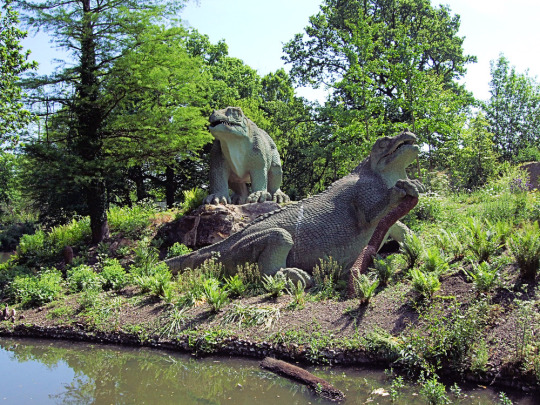
A clearer view by Jim Linwood (CC BY 2.0)
Considering that the skull of Iguanodon wasn't actually known at the time of these sculpture's creation, the head shape with a beak at the front of the jaws is actually an excellent guess. The only major issue was the nose horn, which was an understandable mistake when something as strange as a giant thumb spike had never been seen in any known animal before.

(The fossils the Crystal Palace statues are based on are actually now classified as Mantellisaurus atherfieldensis, but the "modern" reconstruction above depicts the chunkier Iguanodon bernissartensis.)
———
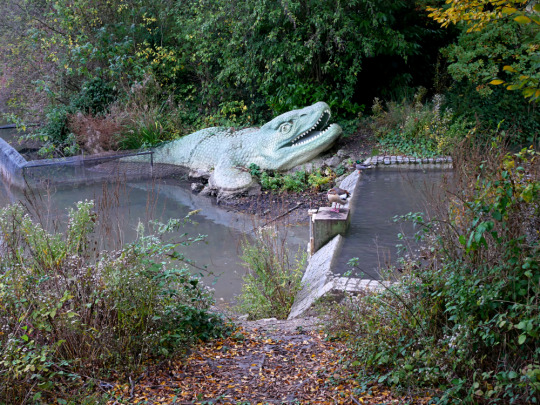
Image by Doyle of London (CC BY-SA 4.0)
I also wasn't able to spot the Cretaceous mosasaur on the other side of the island due to heavy foliage obscuring the view.
Depicting Mosasaurus hoffmannii, this model consists of only the front half of the animal lurking at the water's edge. It's unclear whether this partial reconstruction is due to uncertainty about the full appearance, or just a result of money and time running out during its creation.
The head is boxier than modern depictions, and the scales are too large, but the monitor-lizard like features and paddle-shaped flippers are still pretty close to our current understanding of these marine reptiles. It even apparently has the correct palatal teeth!

Next time: the final Cenozoic section!
#field trip!#crystal palace dinosaurs#retrosaurs#i love them your honor#crystal palace park#crystal palace#ichthyosaur#plesiosaur#teleosaurus#crocodylomorpha#marine reptile#megalosaurus#theropod#hylaeosaurus#ankylosaur#iguanodon#ornithopoda#ornithischia#dinosaur#pterodactyle#pterodactylus#pterosaur#mosasaurus#mosasaur#paleontology#vintage paleoart#art
459 notes
·
View notes
Text

'Oolitic land reptiles - restored forms of Megalosaurus and Hylaeosaurus' from The past and present life of the globe. Being a sketch in outline of the world’s life-system by David Page, 1861
https://archive.org/details/pastpresentlifeo00pagerich/page/138/mode/1up
55 notes
·
View notes
Text
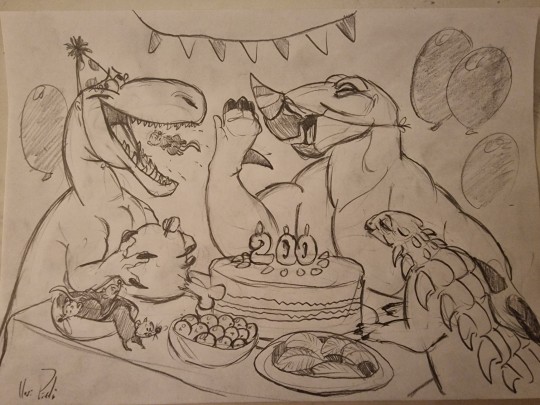
Today is the 200th birthday of Megalosaurus! So to celebrate the occasion, his two old friends; Iguanodon and Hylaeosaurus, decided to throw him a surprise birthday party!
Looks like they're having one heck of a time!
Happy Megalosaurus bicentennial, folks! We've now known of dinosaurs for 200 years. It's something worth celebrating!
#paleoart#stylized paleoart#palaeo cartoon#megalosaurus#iguanodon#hylaeosaurus#megalosaurus bicentennial#Happy Birthday Megalosaurus
51 notes
·
View notes
Text

Walking Tanks, 2023
22 notes
·
View notes
Text

Happy belated 200th birthday as a reconstructed abomination to this goofy goober (=Megalosaurus [shown here eating a misassembled Iguanodon])
9 notes
·
View notes
Text
Hylaeosaurus

Hylaeosaurus is a herbivorous ankylosaurian dinosaur that lived about 136 milliion years ago, in the early Cretaceous period of England. Hylaeosaurus was one of the first dinosaurs to be discovered, in 1832 by Gideon Mantell. Only limited remains have been found of Hylaeosaurus and much of its anatomy is unknown. Hylaeosaurus was about 5 m long, and estimated around 2 t. It was an armored dinosaur that carried at least three long spines on its shoulder.
84 notes
·
View notes
Text




I'll admit it, I have a bit of a soft spot for old depictions of dinosaurs like this. While they certainly didn't age well, you have to remember that they were working with literal scraps and fragments of bone at the time. Plus, the usual method of identifying long extinct animals was usually by comparing their remains to living species. Dinosaurs vaguely resembled reptiles, so it would've made sense to depict them as lizards.
Not to mention these guys were literally among the first depictions of dinosaurs in media. The chances of them being 100% accurate on the first try are pretty dang slim.
I feel that we do need to remember where we came from in terms of paleontology and...well anything really if we are to fully appreciate the field. And these early depictions definitely did help set the groundwork for dinosaur research as a whole. The Crystal Palace Dinosaurs in particular helped foster the public's interest in dinosaurs that still lasts to this very day.
-Statues come from the Crystal Palace Dinosaurs, sculpted by Benjamin Waterhouse Hawkins and directed by Sir Richard Owen
-Hylaeosaurus illustrated by S.G. Goodrich for Animal Kingdom Illustrated
-Megalosaurus and Iguanodon wood carved by Rio Édouard
#dinosaur#dinosaurs#retro paleoart#paleontology#paleoart#paleomedia#iguanodon#megalosaurus#hylaeosaurus#old school dinosaurs#crystal palace dinosaurs
18 notes
·
View notes
Text
🦖🦚Happy 200th dinoversary! 🦕🦜
On 20 February 1824, William Buckland presented Megalosaurus to the Geological Society of London, marking the very first non-avian dinosaur ever scientifically described, meaning we have known about dinosaurs for two full centuries as of today!
#dinosaur#megalosaurus#palaeoblr#the term dinosaur wasn't used until richard owen defined it in 1842 using the three non-avian dinosaurs known at the time#megalosaurus iguanodon and hylaeosaurus#hylaeosaurus is very much the janetty of that group
5 notes
·
View notes
Text
Today Marks 200 Years of Dinosaurs!!
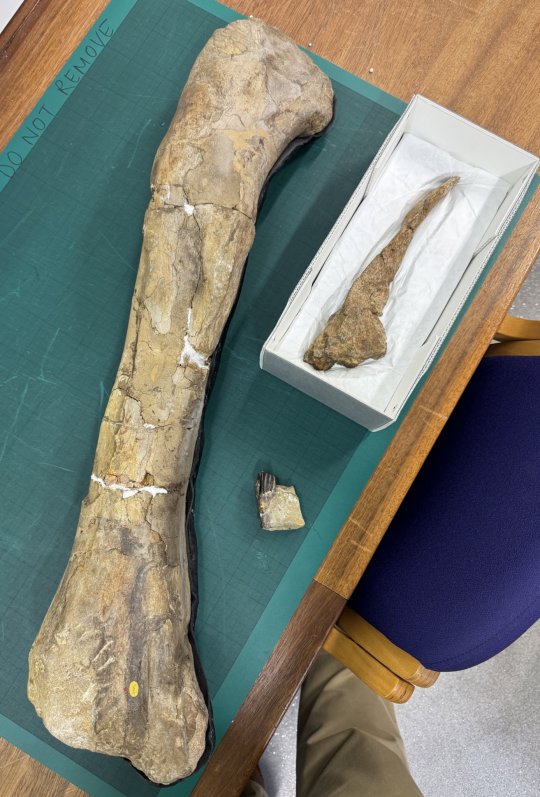
Photo by Paul Barrett (image link here).
On this day, February 20th, 1824, bones from the Stonesfield Slate in Oxfordshire, England were described by William Buckland. Dinosaur fossils have likely been known since time immemorial, but that day was the first time a dinosaur had been described by western science (being the predatory Megalosaurus). Two decades later, Richard Owen would use the three fossils shown above - belonging to three separate animals Megalosaurus (leg), Iguanodon (tooth), and Hylaeosaurus (spine) - to formally recognize Dinosauria as a lineage of animals. Today over a thousand Mesozoic dinosaur genera are known, with many being described on a monthly basis, and our understanding of these animals has grown tremendously since the 1820s. We now recognize that dinosaurs were sophisticated, highly active reptiles with diverse behaviors of which one lineage survived the great Cretaceous Mass Extinction Event: the birds. Paleontologist Darren Naish has said that dinosaurs are popular "because they look neat, because they're awesome in every sense of the word, because they ruled a vast, chaotic, complex wilderness, and because they're the source of a myriad of big, really interesting questions". And I'm sure we all couldn't agree more.
So here's to 200 Years of Dinosaurs! How will you celebrate one of the world's most popular and incredible animals?
1K notes
·
View notes
Text
Vectipelta barretti Pond et al., 2023 (new genus and species)

(Preserved bones and schematic skeletal of Vectipelta barretti [scale bar = 1 m], from Pond et al., 2023)
Meaning of name: Vectipelta = Isle of Wight shield [in Latin]; barretti = for Paul M. Barrett [British paleontologist]
Age: Early Cretaceous (Barremian)
Where found: Wessex Formation, Isle of Wight, U.K.
How much is known: Partial skeleton of one individual including much of the vertebral column, some limb bone fragments, and many armor plates. Some additional ankylosaur material from the same locality may belong to the same species (or even the same individual), but this cannot be confirmed at present.
Notes: Vectipelta was an ankylosaur, a group of armored herbivorous dinosaurs. Two other ankylosaurs have known from the Early Cretaceous of England since the 19th Century, the older Hylaeosaurus and the younger Polacanthus. However, Vectipelta appears to have been only distantly related to either of them, and may have instead been more closely related to the club-tailed ankylosaurine ankylosaurs. Traditionally, ankylosaur fossils from the Wessex Formation have often been classified as Polacanthus by default, but the discovery of Vectipelta indicates that this is not always a safe assumption to make.
Reference: Pond, S., S.-J. Strachan, T.J. Raven, M.I. Simpson, K. Morgan, and S.C R. Maidment. 2023. Vectipelta barretti, a new ankylosaurian dinosaur from the Lower Cretaceous Wessex Formation of the Isle of Wight, UK. Journal of Systematic Palaeontology 21: 2210577. doi: 10.1080/14772019.2023.2210577
108 notes
·
View notes
Text
The first 3 dinosaurs

10 notes
·
View notes
Text
Badly Summarized Dinosaurs (Part 1)
Yutyrannus: Giant Proceratosaurus with a coat and a cool hat.
Psittacosaurus: No, it's not "puh-sit-uh-cuh-sawr-us", the P is silent. also tacos and cloacas.
Utahraptor: Velociraptor cosplaying as an Allosaurus
Thyreosaurus: Stegosaurus cosplaying as an Ankylosaurus
Stegouros: Tiny ankylosaurus cosplaying as a stegosaurus
Kunbarrasaurus: Medium ankylosaurus cosplaying as a stegosaurus
Antarctopelta: big ankylosaurus cosplaying as a stegosaurus
Deinocheirus: Gallimimus cosplaying as a Therizinosaurus
Suskityrannus: Adorable littol guy. probably gets clapped by everything else in its environment but I love him.
Supersaurus: Morrison formation sauropod
Apatosaurus: Yet another morrison formation sauropod
Brontosaurus: Another another morrison formation sauropod
Brachiosaurus: Morrison Formation Sauropod 2: The armininginginginginging
Diplodocus: Morrison Formation sauropod but long.
Opisthocoelicaudia: Morrison Formation sauropod- Okay just stop at this point.
Barosaurus: STOP.
Nothronychus: Y'know how paleontologists said Therizinosaurs were like ground sloths? well this guy is named after that.
Therizinosaurus: Freddy krueger but a chicken!
Stegosaurus: The greater doritoback.
Kentrosaurus: The lesser doritoback
Huayangosaurus: The chinese doritoback
Gigantspinosaurus: Winged Doritoback
Miragaia: Stegosaurus cosplaying as a diplodocus.
Alcovasaurus: What the fuck.
Dravidosaurus: Forget-me-not
Akainacephalus: Spikier Ankylosaurus
Euoplocephalus: what happens when you let a teen ankylosaurus steal a gigantspinosaurus' shoulder spikes.
Scolosaurus: Generic Ankylosaur i guess.
Ankylosaurus: superglued together.
Zuul: Who gonna call? No one because ghosts aren't real.
Arenysaurus: WHO LET THE PARASAUROLOPHUS BECOME SPANISH.
Ajnabia: Swimmy boi.
Parasaurolophus: The dominant species of canada.
Edmontosaurus: Small shantungosaurus
Shantungosaurus: Large edmontosaurus
Saurolophus: Still in a copyright dispute with Parasaurolophus
Lambeosaurus: Offended by PBS Kids.
Corythosaurus: ROMAN GLADIATOR TIMEEEEE
Ampelosaurus: Armored baguette.
Tarascosaurus: Rude Baguette.
Pyroraptor: Burnt Baguette.
Cetiosaurus: Am not whale.
Iguanodon: I do not have a nose horn, mantell- STOP I DO NOT HAVE A HORN- STOP IT MANTELL BAD BOY DOWN DOWN BAD BOY!
Hylaeosaurus: Silly little guy, jealous of her brother and sister.
Megalosaurus: The real queen of the dinosaurs.
Baryonyx: The symbol of britain.
Ceratosuchops: Smart Twin
Riparovenator: Dumb Twin
Suchomimus: Actually, they're triplets but this ones always forgotten about.
Protathlitis: Who the fuck are you.
Iberospinus: ...This is getting ridiculous.
Vallibonavenatrix: THATS IT I AM LEAVING.
15 notes
·
View notes
Text

Panorama showing animals of the Secondary, Tertiary, and Quaternary Eras, folding hand-colored engraving, from Isabelle Duncan, Pre-Adamite Man, 1860
https://www.lindahall.org/about/news/scientist-of-the-day/isabelle-duncan/
#megatherium#mammoth#irish elk#deinotherium#pterodactyl#megalosaurus#iguanodon#labyrinthodon#ichthyosaurus#hylaeosaurus#benjamin waterhouse hawkins#1860#isabelle duncan#megaloceros
36 notes
·
View notes
Text
#thyreophora#dinosaurs#stegosaurus#ankylosaurus#polls#palaeoblr#prehistoric life#stegosaurs#ankylosaurs#zuul
149 notes
·
View notes